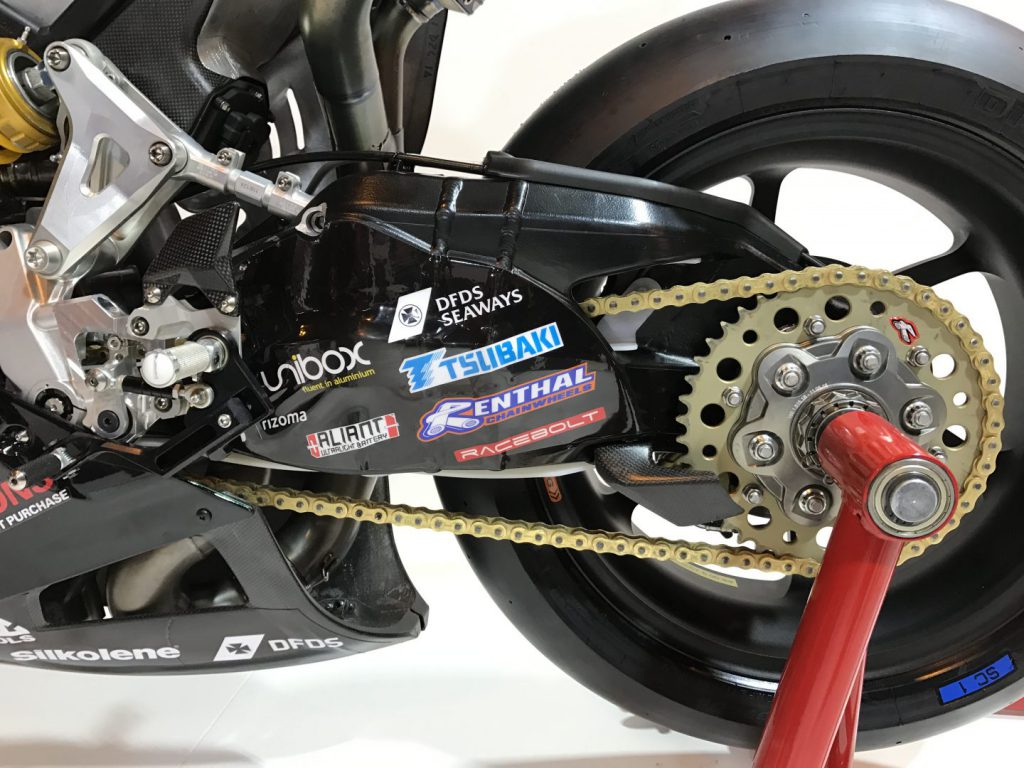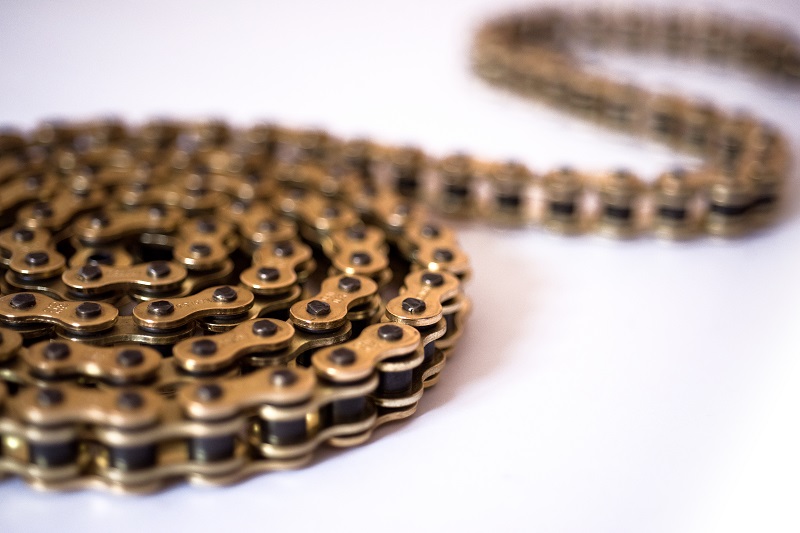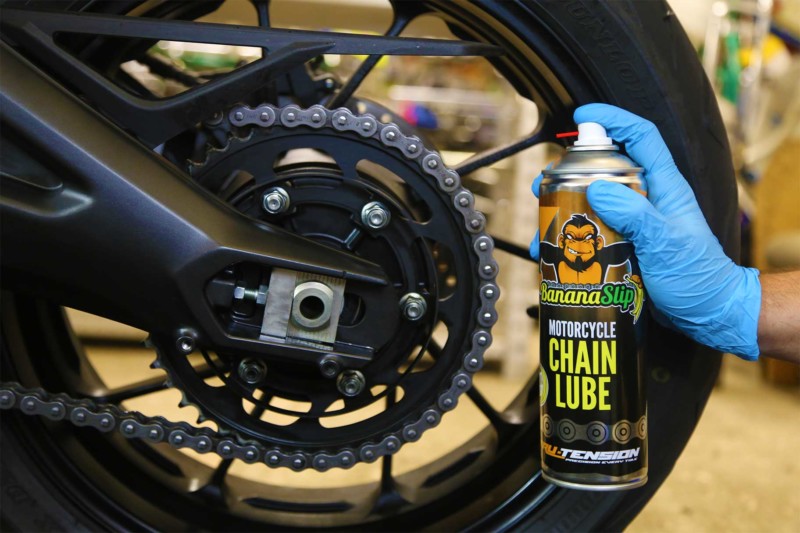
We all love to spend our hard earnings on the blingy parts and go faster bits for our motorcycles, but some parts are often overlooked. Continue reading for all the info on motorcycle chains and sprockets
Brakes are one example here, and something we’ve touched on earlier, and your motorcycle’s transmission is one that is right up there! We can fit the stickiest tyres, a nice sounding exhaust and plenty of go faster bits, but we need a well-maintained transmission to put all that onto the road…
Nearly all motorcycles on the market today (apart from a few shaft or belt driven bikes) use a chain and a pair of sprockets to transfer the drive to the rear wheel. The front sprocket is attached to the output shaft of the engine with the rear sprocket attached to the rear wheel. The teeth on the sprockets engage with the pins on the motorcycles drive chain, powering the rear wheel and moving the bike forward.
The necessity to fit the correct chain for your bike (which we’ll touch on later) is important as this pulling force from the engine is transferred via the chain, through its pins and side plates to the rollers. The correct pitch of chains is also important, as this ensures the chain fits snugly around the sprockets and distributes the driving forces equally.

Motorcycle Chains
Motorcycle chains are available in numerous different combinations of size, pitch and colour; but the construction of the chains is essentially the same… Inner and outer plates are connected by pins which pass through a bushing in the inner plates, with rollers over the top of these to reduce friction and extend chain and sprocket life.
Basic roller chains like these are often fitted to smaller capacity bikes for cost, but they are not sealed (so effectively have no lubrication between the bushes and the rollers) and can wear quite quickly if they are not cleaned and lubricated regularly. Non-sealed chains should be lubricated every 100 miles to give good service life and longevity.
A sealed roller chain is a different story all together. Although they follow the same basic construction, these chains have a rubber seal between the side plates and the bushes to keep lubrication in and stop dirt, water and grime from the roads from penetrating the chain and increasing chain wear. The seals used are quite varied and most manufacturers have their own designs, with the most common being O-ring or X-ring shaped seals – but others include U-ring, XW-rings to name a few. Sealed chains should be lubricated every 300 miles to offer the required service life.
Motorcycle chains are also manufactured in different pitches and strengths, and to suit different bikes. A 1000cc bike will need a chain with a lot more ensile strength to cope with the torque and the power of the engine, as opposed to a chain fitted to a 125cc bike which will not give the chain as much of a hard time. This is one of the most important factors to consider when buying a motorcycle chain, as making sure we buy the correct grade of chain for our bike will eliminate the chance of premature wear, chain failure and/or expensive damage to our engines (or ourselves!)
The pitch of the chain is effectively the size of the chain – not the length, but the diameter and width of the rollers, which is vital as the chain needs to fir the rollers properly for them to work correctly together.



The final choice with your chain is its colour! I know this may seem irrelevant to some, but it can be a good way or personalising your machine, too! Most standard chains are silver in colour, but more and more sealed chains are available with their outer plates in other colours such as black, gold (the most popular), red, blue, green and even orange!
It can seem a little confusing or overwhelming at first to find the right chain for your bike, but our bike selector will show you the correct options and the best quality chains for your bike!

Motorcycle Sprockets
Just as essential as your chain is picking the right sprockets for your bike! Motorcycle sprockets are available in numerous designs and manufactured from various materials.
When picking a rear sprocket, without a doubt the most popular choice for users and most common material they are made from is steel. Steel rear sprockets are chosen for most road bikes as they offer greater longevity than, say, aluminium rear sprockets – which are often chosen by racers or track-day enthusiasts as they are lighter, but wear faster (on the track mileage isn’t as much of a consideration as weight).
Front sprockets are also predominantly made from steel, although there are more “race” orientated versions from companies such as Renthal, who use different materials to reduce weight but still offer maximum strength.
Most sprockets are available in different sizes, but you motorcycle will have a pre-determined sprocket size for front and rear from the factory as the manufacturer believes this offers the best combination of acceleration and top speed. It is possible on most motorcycles to change the sizes of sprocket to increase top speed or acceleration, but there is a compromise between the two as quicker acceleration will reduce top speed and more top speed will reduce acceleration – for this reason, we recommend keeping the gearing standard on road bikes and keeping the gearing changes for the track!
When Should I Change a Motorcycle Chain or Sprocket?
Chains and sprockets are not invincible and even if we keep them clean, lubricated and well maintained they will still wear out eventually. Your chain passes over your sprocket thousands of times a minute and slowly the teeth on your sprocket begin to wear away and can have a “hooked” look to the tips of the teeth after a while. The same applies to your chain – over time the pins, rollers and bushings wear, which can effectively cause the chain to elongate and “stretch” to the point where you have no adjustment left.
It is highly recommended to change your chain and sprockets together. When new, the sprockets and chain fit perfectly and the pitches are the same, meaning they will wear together over time. If you fit a new chain to worn sprockets, the pitch of the chain will not match properly and speed up the wear on the chain and in the same way, fitting new sprockets to a worn chain will speed up wear on the sprockets.
Motorcycle Chain and Sprocket Kits

Some people like to buy their chains and sprockets individually and this is perfect if you ride on the track, want to change the gearing on your bike or fit different manufacturer’s sprockets. For most of us who ride on the road, the easiest option is to purchase a chain and sprocket kit, which includes standard sized front and rear sprockets and a chain of the correct length and grade for your motorcycle.
We stock a huge range of chain and sprocket kits from AFAM, RK, DID, DC and Renthal who all offer a “standard” spec kit with an OE grade of chain, or as an “upgrade” kit which will come with an upgraded chain over OE to offer better mileage etc.

Motorcycle Chain and Sprocket Maintenance
Maintenance and adjustment are the most crucial factors that affect the life of your chain and sprockets. It is vital that you keep your chain clean and well lubricated to ensure it does not get covered in surface rust and that it works to its maximum potential. Lubricating your chain regularly (every 300 miles for a sealed chain, 100 miles for a non-sealed chain or after evet wet weather ride) will ensure that the most common chain problems can be avoided, such as:
- Excessive wear on the pins (shorter chain life)
- Rough contact with sprockets (Increases noise)
- Stiff links (reduces mileage of chain)
Your chain should be lubricated between the outer links and inner links to prevent elongation and also between the bushings and inner plates to reduce noise and protect against wear on the rollers. All modern chain lubes are very good, but the annoying “fling” of lube we get can be avoided if we try not to put too much lube on the chain and by lubricating your chain after a ride when it is warm, as the chain lube reaches all parts of the chain easier.
Something to bear in mind
A couple of other things to remember are to ensure your wheel alignment is spot on and the sprockets are in line to get the maximum lifespan. Misaligned sprockets can increase the noise of your drive train, increase wear and sometimes produce tight spots in your chain.
Your chain adjustment is also a factor. A chain that is too tight will increase wear on the sprockets, chain joints and shaft bearings while a chain that is too slack will increase chain wear, but also create a “whip” effect in the chain that can cause it to snap. Ensuring we have the correct chain tension (this will be in your handbook or workshop manual) will ensure correct operation and maximum performance.
Enjoyed this? Read more of our latest news:
Where To Next?
Looking for the latest motorcycle parts and accessories? Check out our wide range from top brands.
Come and visit us at our store, showroom and fitting centre in Wrexham.
Want to know more about our story? Learn about who we are and why we’ve been driven by passion for over 50 years.
Interested in everything we do? Catch up on all the latest Demon Tweeks news.
